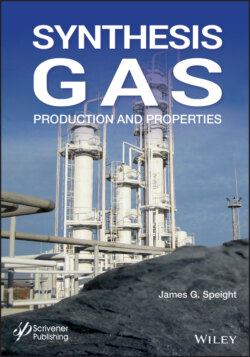Читать книгу Synthesis Gas - James Speight G., James G. Speight - Страница 56
2.5.6 Physical Effects
ОглавлениеDepending on the type of feedstock being processed and the analysis of the gas product desired, pressure also plays a role in product definition. In fact, some (or all) of the following processing steps will be required: (i) pretreatment of the feedstock, (ii) primary gasification of the feedstock, (iii) secondary gasification of the carbonaceous residue from the primary gasifier, (iv) removal of carbon dioxide, hydrogen sulfide, and other acid gases, (v) shift conversion for adjustment of the carbon monoxide/hydrogen mole ratio to the desired ratio, and (vi) catalytic methanation of the carbon monoxide/hydrogen mixture to form methane.
Most notable effects in the physical chemistry of the gasification process are those effects due to the chemical character of the feedstock as well as the physical composition of the feedstock (Speight, 2011a, 2013). In more general terms of the character of the feedstock, gasification technologies generally require some initial processing of the feedstock with the type and degree of pretreatment a function of the process and/or the type of feedstock. For example, the Lurgi process will accept lump feedstock (1 in., 25 mm, to 28 mesh), but it must be non-caking with the fines removed – feedstock that show caking or agglomerating tendencies form a plastic mass in the bottom of a gasifier and subsequently plug up the system thereby markedly reducing process efficiency. Thus, some attempt to reduce caking tendencies is necessary and can involve preliminary partial oxidation of the feedstock thereby destroying the caking properties.
Another factor, often presented as very general rule of thumb, is that optimum gas yields and gas quality are obtained at operating temperatures of approximately 595 to 650oC (1100 to 1200oF). A gaseous product with a higher heat content (BTU/ft.3) can be obtained at lower system temperatures but the overall yield of gas (determined as the fuel-to-gas ratio) is reduced by the unburned char fraction.
The major difference between combustion and gasification from the point of view of the chemistry involved is that combustion takes place under oxidizing conditions, while gasification occurs under reducing conditions. In the gasification process, the feedstock (in the presence of steam and oxygen at high temperature and moderate pressure) is converted to a mixture of product gases. In the initial stages of gasification, the rising temperature of the feedstock initiates devolatilization of the feedstock and the breaking of weaker chemical bonds to yield tar, oil, volatile species, and hydrocarbon gases. These products generally react further to form hydrogen, carbon monoxide, and carbon dioxide. The fixed carbon that remains after devolatilization reacts with oxygen, steam, carbon dioxide, and hydrogen.
Depending on the gasifier technology employed and the operating conditions, significant quantities of water, carbon dioxide, and methane can be present in the product gas, as well as a number of minor and trace components. Under the reducing conditions in the gasifier, most of the sulfur in the fuel sulfur is converted to hydrogen sulfide (H2S) as well as to smaller yields of carbonyl sulfide (COS). Organically bound nitrogen in the feedstock is generally (but not always) converted to gaseous nitrogen (N2) – some ammonia (NH3) and a small amount of hydrogen cyanide (HCN) are also formed. Any chlorine in the feedstock (such as coal) is converted to hydrogen chloride (HCl) with some chlorine present in the particulate matter (fly ash). Trace elements, such as mercury and arsenic, are released during gasification and partition among the different phases, such as fly ash, bottom ash, slag, and product gas.
Fuels for gasification reactors differ significantly in chemical properties, physical properties, and morphological properties and, hence, require different reactor design and operation. It is for this reason that, during more than a century of gasification experience, a large number of different gasifiers has been developed – each reactor designed to accommodate the specific properties of a typical fuel or range of fuels. In short, the gasification reactor that is designed to accommodate all (or most) types of fuels does not exist.
However, before choosing a gasifier for any individual fuel it is important to ensure that the fuel meets the requirements of the gasifier or that it can be treated to meet these requirements. Practical tests are needed if the fuel has not previously been successfully gasified. In other words the fuel must match the gasifier and the gasifier must match the fuel.
